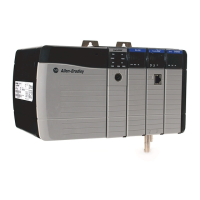Rockwell Automation Publication 1756-RM003N-EN-P - October 2011 527
Special Instructions (FBC, DDT, DTR, PID) Chapter 13
Zero-crossing is deadband control that lets the instruction use the error for
computational purposes as the process variable crosses into the deadband until
the process variable crosses the setpoint. Once the process variable crosses the
setpoint (error crosses zero and changes sign) and as long as the process variable
remains in the deadband, the output will not change.
The deadband extends above and below the setpoint by the value you specify.
Enter zero to inhibit the deadband. The deadband has the same scaled units as
the setpoint. You can use the deadband without the zero-crossing feature by
selecting the ‘no zero crossing for deadband’ option on the Configuration tab
or set the .NOZC bit in the PID structure.
If you are using the deadband, the Control variable must be REAL or it will be
forced to zero when the error is within the deadband.
Use Output Limiting
You can set an output limit (percentage of output) on the control output.
When the instruction detects that the output has reached a limit, it sets an
alarm bit and prevents the output from exceeding either the lower or
upper limit.
Feedforward or Output Biasing
You can feedforward a disturbance from the system by feeding the .BIAS value
into the PID instruction’s feedforward/bias value.
The feedforward value represents a disturbance fed into the PID instruction
before the disturbance has a chance to change the process variable.
Feedforward is often used to control processes with a transportation lag. For
example, a feedforward value representing ‘cold water poured into a warm mix’
could boost the output value faster than waiting for the process variable to
change as a result of the mixing.
A bias value is typically used when no integral control is used. In this case, the
bias value can be adjusted to maintain the output in the range required to keep
the PV near the setpoint.
Cascade Loops
The PID cascades two loops by assigning the output in percent of the master
loop to the setpoint of the slave loop. The slave loop automatically converts the
output of the master loop into the correct engineering units for the setpoint of
the slave loop, based on the slave loop’s values for .MAXS
and .MINS.

